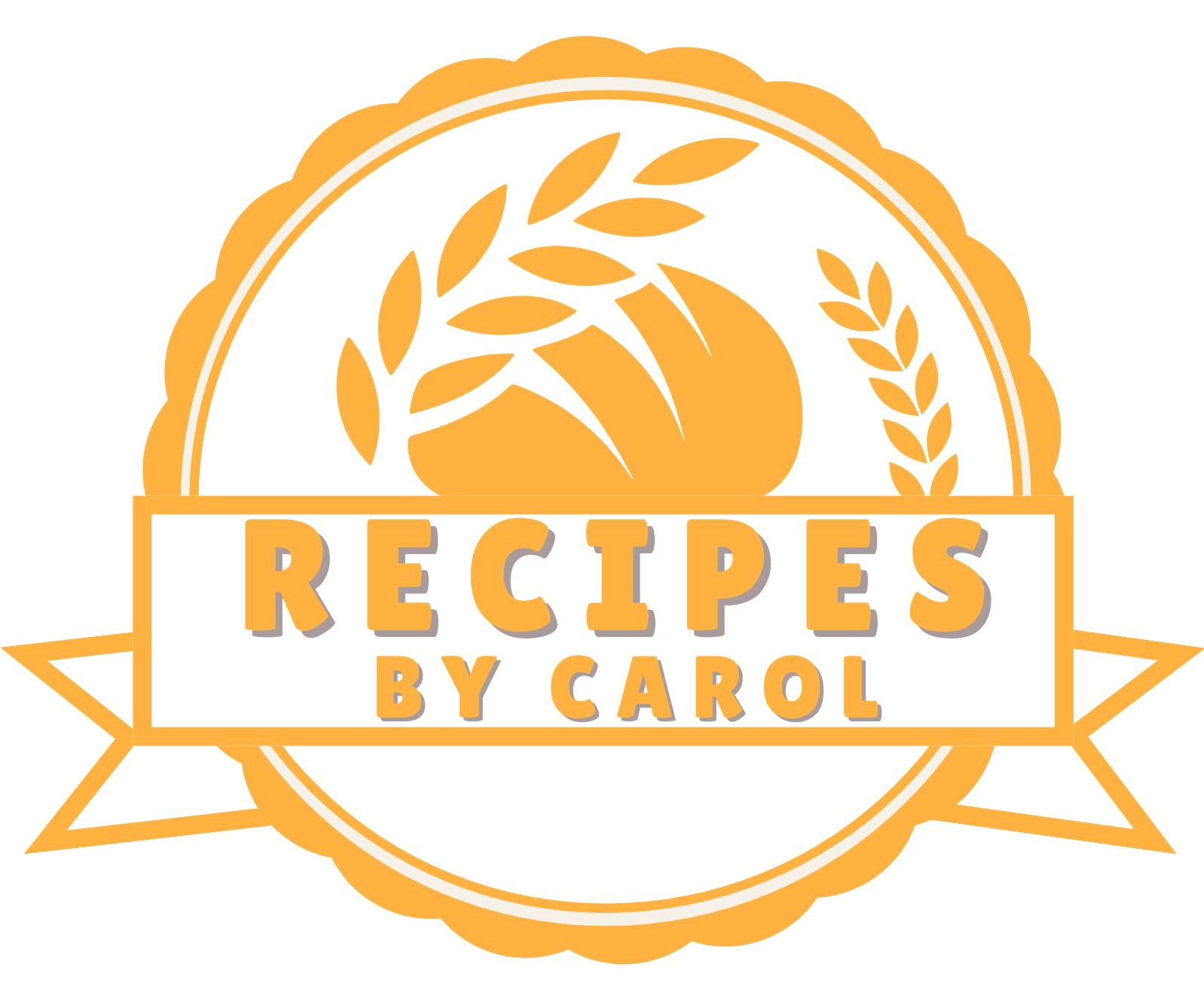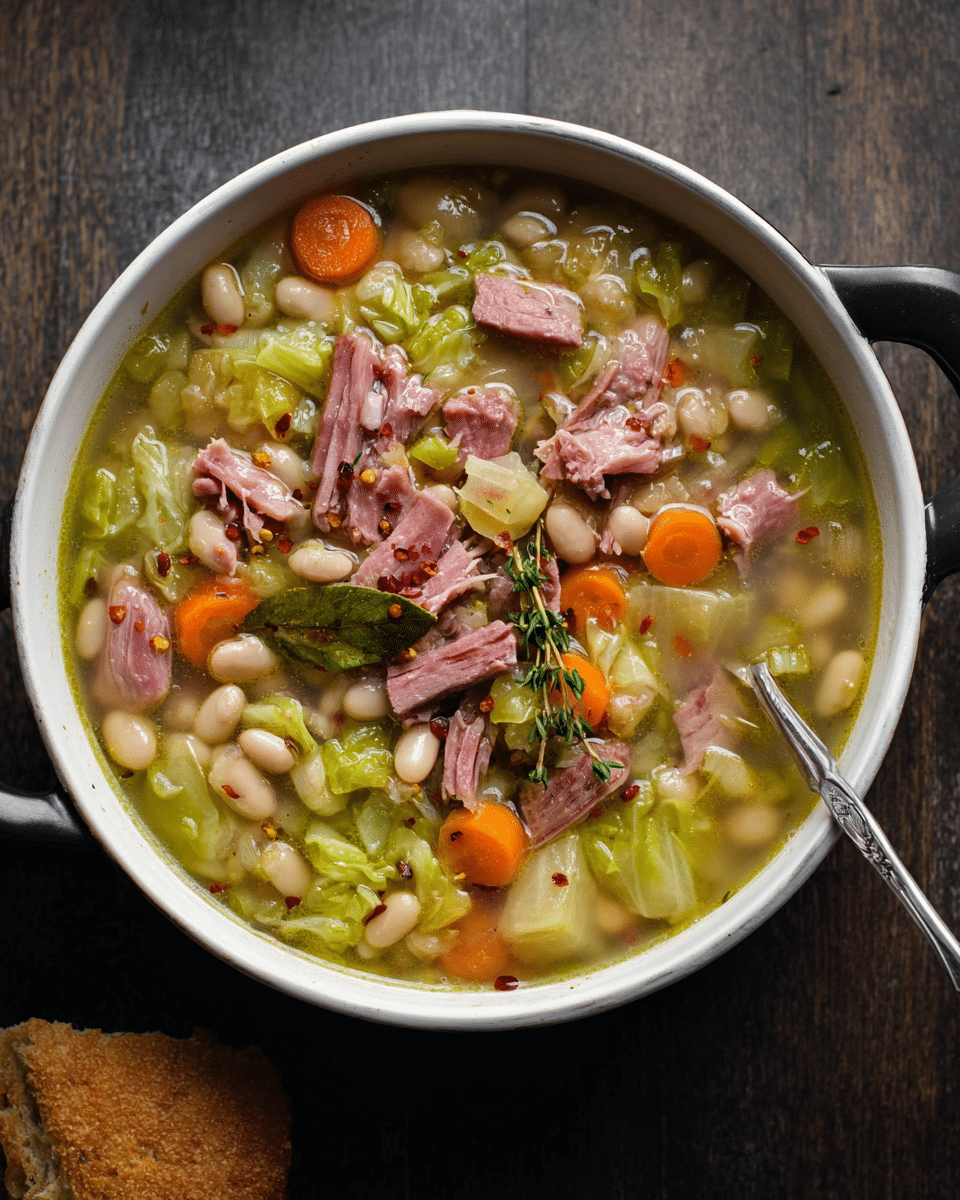This Garbure is a testament to the heart and soul of French peasant cooking simple ingredients transformed by time and tradition. Smoked ham hock infuses the broth with savory depth, while tender white beans, shredded savoy cabbage, and root vegetables bring balance and body. The long, slow simmer develops a hearty texture, meant to fortify against the coldest of days.
Thick enough to hold a ladle upright, this dish is more stew than soup a meal in a bowl. Whether you’re serving a crowd or making a big batch to enjoy throughout the week, Garbure delivers both nourishment and nostalgia. Rustic, smoky, and deeply satisfying, it’s a timeless comfort food from the French countryside.
Full Recipe:
Ingredients:
-
8 oz (225g) dried white beans
-
2.5 lbs (1.15kg) smoked ham hock
-
1 large onion, peeled
-
8–10 whole cloves (spice)
-
1 celery branch
-
4 bay leaves
-
4–5 thyme sprigs
-
3 ½ tbsp (50g) duck fat (or butter)
-
2 garlic cloves, crushed
-
2 large carrots, peeled and cubed
-
1 large turnip, peeled and cubed
-
1 leek, sliced into ½-inch half rounds
-
½ medium savoy cabbage, shredded
-
3–4 Russet potatoes, peeled and cubed
-
1 tsp red pepper flakes
-
Salt and pepper, to taste
Directions:
-
Soak the white beans overnight in cold water, or for at least 12 hours.
-
The next day, poke the cloves into the peeled onion.
-
In a large stockpot, combine the clove-studded onion, celery, bay leaves, thyme, and smoked ham hock.
-
Add 18 cups (4.5 liters) of water or enough to fully submerge the ham hock.
-
Bring to a boil, reduce to low, and simmer for 1 hour, covered.
-
In a separate frying pan, melt duck fat over medium-high heat. Add garlic, carrots, turnip, and leek. Sauté for 6–7 minutes until leek is translucent.
-
Drain the soaked beans and add them to the broth along with the sautéed vegetables. Season with salt and pepper. Simmer for 1 hour, covered.
-
Meanwhile, blanch the cabbage: boil salted water, add cabbage, and cook for 3 minutes. Drain and cool under cold water. Set aside.
-
After 1 hour, stir the blanched cabbage into the soup and simmer for 30 minutes, covered.
-
Add the potatoes and simmer for another 30 minutes, covered.
-
Remove ham hock, discard the skin and bones, shred the meat and return it to the pot.
-
Remove the herbs, celery, and onion. Chop the onion and celery and return them to the soup. Discard the cloves and herbs.
-
Simmer uncovered for an additional 15 minutes to thicken the soup. The soup is ready when a ladle stands upright in the pot.
-
Serve with red pepper flakes and crusty bread.
Prep Time: 15 minutes | Cooking Time: 3.5 hours | Total Time: 3 hours 45 minutes
Kcal: ~370 kcal per serving | Servings: 8
Garbure: A Hearty Taste of French Mountain Heritage
In the rolling hills of Gascony and the shadow of the Pyrenees, where snowcaps kiss the skyline and life moves with a gentle, pastoral rhythm, a humble yet powerful dish has warmed French tables for centuries. Known as Garbure, this smoked ham hock, bean, and cabbage soup is more than a recipe it’s a story of survival, of rural identity, and of a deep respect for seasonal cooking.
Though many people encounter Garbure as a comforting cold weather soup, its origins reach far deeper into the culture and traditions of southwestern France. What began as a dish of necessity created from the garden’s final offerings and the preserved meats of winter has become a celebrated staple in both home kitchens and rustic restaurants across the region.
A Dish of the People: Origins of Garbure
Garbure emerged from the rural heartland of France, specifically the Béarn and Gascony regions. Like many peasant dishes, it was born from the ingredients that were most accessible to farmers and villagers. In an era before supermarkets and year-round produce, cooking was governed by necessity, thrift, and the ingenuity of making simple ingredients sing.
The soup began as a seasonal amalgam of cabbage, root vegetables, and legumes harvested from personal plots and prepared in large quantities to feed families for days. Meat was added when it was available, and often that meant preserved or cured varieties. Smoked ham hock became the ideal candidate: a cut packed with flavor, collagen, and just enough fat to enrich the broth.
Over time, this humble fare began to evolve. Though still tied to its rustic roots, Garbure eventually incorporated luxurious additions in some regions, such as duck confit or sausage. But in its truest form the one passed down through generations it remains a thick, nourishing soup of vegetables, beans, and the unmistakable smoky depth of pork.
A Signature of French Mountain Cooking
What sets Garbure apart from other bean or cabbage soups is its robust texture and deeply layered flavor. Traditionally, the soup was considered “ready” only when a wooden soup ladle could stand upright in the pot a testament to its density and heartiness. It’s not uncommon to refer to Garbure as “a meal in a bowl,” and this is no exaggeration.
In many French homes, the preparation of Garbure is an act of reverence. It is usually cooked in large batches over several hours, often on a lazy Sunday or during a holiday when the pace of life allows for a slow simmer and lingering aromas. The scent of smoked ham blending with earthy cabbage and mellow beans has the power to draw an entire family to the kitchen, no matter the time of day.
In the Pyrenees especially, where winters can be long and unforgiving, Garbure was a lifeline. It provided warmth, sustenance, and nourishment during cold seasons when other fresh ingredients were scarce. The beans offered protein and bulk; the cabbage and potatoes delivered fiber and nutrients; and the ham hock contributed salt, fat, and an umami-rich base that could elevate the simplest broth.
The Beauty of Slow Cooking
A major part of Garbure’s charm lies in the slow-cooking process. Unlike fast-paced weeknight meals, this dish asks for time and patience. The result is worth every minute.
The initial broth begins with a smoked ham hock simmered with aromatics like onion studded with cloves, thyme, bay leaves, and celery. This creates a deeply savory and perfumed stock that is the soul of the soup. Once the beans and hearty vegetables are introduced, they absorb every note of the broth’s character.
Savoy cabbage prized for its firm texture and ability to hold up during long cooking plays a starring role. While ordinary cabbage might become mushy, Savoy retains a satisfying bite, even after hours in the pot. Similarly, Russet potatoes contribute to the creaminess of the soup, subtly thickening the liquid as they cook and break down.
Though modern pressure cookers or instant pots might reduce the cooking time, traditionalists agree that the soul of Garbure lies in its long, slow evolution on the stove. It’s a recipe that doesn’t just cook it develops, deepening in both flavor and sentiment with each passing hour.
Adaptability Through the Seasons
One of the most delightful aspects of Garbure is its adaptability. No two versions are entirely alike, and that’s the beauty of it. Depending on what’s in season or what’s left in the pantry, Garbure becomes a reflection of the cook’s ingenuity.
Some families will add duck confit, turning the dish into a celebration of French charcuterie. Others might include leftover roast vegetables or substitute turnips for parsnips. Even the beans are flexible though Tarbais beans are traditionally used in France, American cooks may substitute navy or cannellini beans to great success.
It’s this flexibility that has allowed Garbure to persist over generations. Far from a rigid formula, it’s a living recipe one shaped by the land, the season, and the cook.
A Culinary Experience Beyond Flavor
To eat Garbure is to take part in a culinary ritual that connects the eater to centuries of French tradition. In some homes, it’s even served in multiple courses: first, the broth may be ladled into bowls as a starter, followed by the meat and vegetables as a main course. Some will even top it with a slice of stale bread and grated cheese, then broil it briefly for a French style gratinée.
Garbure’s flavors are both subtle and profound. The smoke of the ham is ever-present, but not overpowering. The beans and potatoes create a comforting creaminess, while the cabbage and root vegetables add texture and sweetness. Herbs like thyme and bay leaf infuse the broth with earthy complexity, tying everything together in a seamless harmony.
This dish isn’t just food it’s comfort, memory, and culture in a bowl. Every spoonful tells a story of countryside kitchens, of hands that worked the soil, and of evenings spent around the hearth.
Modern Appeal in a Fast-Paced World
In today’s world of convenience meals and instant gratification, Garbure stands as a delicious reminder of a slower, more intentional way of life. It invites the cook to pause, to plan, and to take joy in the process as much as the result.
It also resonates with modern culinary values: local ingredients, low waste, plant-forward nutrition, and minimal processing. It’s no wonder that Garbure is experiencing a revival among foodies, home chefs, and lovers of French cuisine.
Whether served at a cozy dinner party or prepared in advance for a week’s worth of hearty lunches, Garbure is a recipe that always delivers. Its generous portions, complex flavor, and nourishing base make it a cornerstone of seasonal, sustainable cooking.
Conclusion:
Garbure is not merely a soup it is an expression of regional identity, culinary wisdom, and the art of making do with what’s on hand. Its smoky aroma, rustic presentation, and deeply satisfying flavor profile make it a standout dish that bridges the gap between history and the modern kitchen.
Perfect for cold days, festive occasions, or simply as a heartfelt family meal, Garbure continues to hold its place in the French culinary canon and it deserves a spot in your repertoire as well.
Whether you choose to stick with the traditional ham hock version or experiment with duck confit, legumes, or leafy greens, remember this: Garbure isn’t about precision. It’s about comfort, community, and cooking with love.






